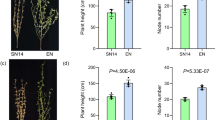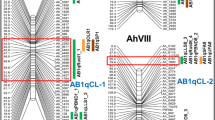Abstract
One of the goals of plant breeding is to increase yield with improved quality characters. Plant introductions (PI) are a rich source of favorable alleles that could improve different characters in modern soybean [Glycine max (L.) Merril] including yield. The objectives of this study were to identify yield QTL underlying the genetic basis for differential adaptation of soybeans to the Canadian, United States or Chinese mega-environments (ME) and to evaluate the relationship and colocalization between yield and agronomic traits QTL. Two crosses between high-yielding Canadian cultivars and elite Chinese cultivars, OAC Millennium × Heinong 38 and Pioneer 9071 × #8902, were used to develop two recombinant inbred line (RIL) populations. Both populations were evaluated at different locations in Ontario, Canada; Minnesota, United States (US), Heilongjiang and Jilin, China, in 2009 and 2010. Significant variation for yield was observed among the RILs of both populations across the three hypothetical ME. Two yield QTL (linked to the interval Satt364–Satt591 and Satt277) and one yield QTL (linked to marker Sat_341) were identified by single-factor ANOVA and interval mapping across all ME in populations 1 and 2, respectively. The most frequent top ten high-yielding lines across all ME carried most of the high-yielding alleles of the QTL that were identified in two and three ME. Both parents contributed favorable alleles, which suggests that not only the adapted parent but also the PI parents are potential sources of beneficial alleles in reciprocal environments. Other QTL were detected also at two and one ME. Most of the yield QTL were co-localized with a QTL associated with an agronomic trait in one, two, or three ME in just one or in both populations. Results suggested that most of the variation observed in seed yield can be explained by the variation of different agronomic traits such a maturity, lodging and height. Novel alleles coming from PI can favorably contribute, directly or indirectly, to seed yield and the utilization of QTL detected across one, two or three ME would facilitate the new allele introgression into breeding populations in both North America and China.
Similar content being viewed by others
References
Agrobase (2000) Agrobase Software. Agronomix Software Inc., Winnipeg
Bowley SR (1999) A hitchhiker’s guides to statistics in plant biology. Any Old Subject Books, a Division of Plants, Inc., Guelph
Braun HJ, Rajaram S, Ginkel M (1996) CIMMYT’s approach to breeding for wide adaptation. Euphytica 92:175–183
Brummer EC, Graef GL, Orf J, Wilcox JR, Shoemaker RC (1997) Mapping QTL for seed protein and oil content in eight soybean populations. Crop Sci 37:370–378
Burnham KD, Dorrance AE, VanToai TT, St Martin SK (2003) Quantitative trait loci for partial resistance to Phytophthora sojae in soybean. Crop Sci 43:1610–1617
Burton JW (1987) Quantitative genetics: results relevant to soybean breeding. In: Wilcox JR (ed) Soybeans: improvement, production, and uses, 2nd edn. American Society of Agronomy, Inc, Madison, pp 211–247
Cianzio SR, Schultz SP, Fehr WR, Tachibana H (1991) Registration of “Archer” soybean. Crop Sci 31:1707
Concibido VC, La Vallee B, McLaird P, Pineda N, Meyer J, Hummel L, Yang J (2003) Introgression of a quantitative trait locus for yield from Glycine soja into commercial soybean cultivars. Theor Appl Genet 106:575–582
Cooper M, Byth DE (1996) Understanding plant adaptation to achieve systematic applied crop improvement—a fundamental challenge. In: Cooper M, Hammer GL (eds) Plant adaptation and crop improvement. CABI, Wallingford, pp 5–23
Cregan PB, Jarvik T, Bush AL, Shoemaker RC, Lark KG, Kahler AL, Kaya N (1999) A new integrated genetic linkage map of the soybean. Crop Sci 39:1464–1490
Egli DB, Fraser J, Leggett JE, Poneleit CG (1981) Control of seed growth in soya beans [Glycine max (L.) Merrill]. Ann Bot 48:171–176
Fasoula VA, Harris DK, Boerma HR (2004) Validation and designation of quantitative trait loci for seed protein, seed oil, and seed weight from two soybean populations. Crop Sci 44:1218–1225
Fehr WR, Caviness DT, Burmood DT, Pennington JS (1971) Stage of development descriptions for soybeans, Glycine max (L.) Merril. Crop Sci 11:929–931
Hyten DL, Pantalone VR, Sams CE, Saxton AM, Landau-Ellis D, Stefaniak TR, Schmidt ME (2004) Seed quality QTL in a prominent soybean population. Theor Appl Genet 109:552–561
Kabelka EA, Diers BW, Fehr WR, Leroy AR, Baianu IC, You T, Neece DJ, Nelson RA (2004) Putative alleles for increased yield from soybean plant introductions. Crop Sci 44:784–791
Li Z, Jakkula L, Hussey RS, Tamulonis JP, Boerma HR (2001a) SSR mapping and confirmation of the QTL from PI96354 conditioning soybean resistance to southern root-knot nematode. Theor Appl Genet 103:1167–1173
Li Z, Qiu L, Thompson JA, Welsh MM, Nelson RL, Merr L (2001b) Molecular genetic analysis of US and Chinese soybean ancestral lines. Crop Sci 41:1330–1336
Manjarrez-Sandoval P, Carter TE, Webb DM, Burton JW (1997) RFLP genetic similarity estimates and coefficient of parentage as genetic variance predictors for soybean yield. Crop Sci 37:698–703
Mansur LM, Orf JH, Chase K, Jarvik T, Cregan PB, Lark KG (1996) Genetic mapping of agronomic traits using recombinant inbred lines of soybean. Crop Sci 36:1327–1336
Orf JH, Chase K, Jarvik T, Mansur LM, Cregan PB, Adler FR, Lark KG (1999a) Genetics of soybean agronomic traits: I. Comparison of three related recombinant inbred populations. Crop Sci 39:1642–1651
Orf JH, Chase K, Adler FR, Mansur LM, Lark KG (1999b) Genetics of soybean agronomic traits: II. Interactions between yield quantitative trait loci in soybean. Crop Sci 39:1652–1657
Palomeque L (2007) Mapping of QTLs associated with adaptation to mega-environments using Canadian × Chinese populations in soybean. Ph.D. thesis, Retrieved from Theses database, Department of Plant Agriculture, University of Guelph
Palomeque L, Liu LJ, Li W, Hedges B, Cober ER, Rajcan I (2009a) QTL in mega-environments: I. Universal and specific seed yield QTL detected in a population derived from a cross of high-yielding adapted × high-yielding exotic soybean lines. Theor Appl Genet 119:417–427
Palomeque L, Liu LJ, Li W, Hedges B, Cober ER, Rajcan I (2009b) QTL in mega-environments: II. Agronomic trait QTL co-localized with seed yield QTL detected in a population derived from a cross of high-yielding adapted × high-yielding exotic soybean lines. Theor Appl Genet 119:429–436
Palomeque L, Liu LJ, Li W, Hedges B, Cober ER, Smid MP, Lukens L, Rajcan I (2010) Validation of mega-environment universal and specific QTL associated with seed yield and agronomic traits in soybeans. Theor Appl Genet 120:997–1003
Panthee DR, Pantalone VR, Sams CE, Saxton AM, West DR, Rayford WE (2004) Genomic regions governing soybean seed nitrogen accumulation. J Am Oil Chem Soc 81:77–81
Reinprecht Y, Poysa VW, Yu K, Rajcan I, Ablett GR, Pauls KP (2006) Seed and agronomic QTL in low linolenic acid, lipoxygenase-free soybean (Glycine max (L.) Merrill) germplasm. Genome 49:1510–1527
SAS ver (2003) SAS. SAS Institute Inc, Cary
Smalley MD, Fehr WR, Cianzio SR, Han F, Sebastian SA, Streit LG (2004) Quantitative trait loci for soybean seed yield in elite and plant introduction germplasm. Crop Sci 44:436–442
Sneller CH (1994) Pedigree analysis of elite soybean lines. Crop Sci 34:1515–1522
Soybase (2011) Soybean breeder’s toolbox genetic map information. http://soybeanbreederstoolbox.org/. Retrieved July 2011
Specht JE, Chase K, Macrander M, Graef GL, Chung J, Markwell JP, Germann M, Orf JH, Lark KG (2001) Soybean response to water: a QTL analysis of drought tolerance. Crop Sci 41:493–509
Thompson JA, Nelson RL (1998) Utilization of diverse germplasm for soybean yield improvement. Crop Sci 38:1362–1368
Ude GN, Kenworthy WJ, Costa JM, Cregan PB, Alvernaz J (2003) Genetic diversity of soybean cultivars from China, Japan, North America, and North American ancestral lines determined by amplified fragment length polymorphism. Crop Sci 43:1858–1867
van Ooijen JM (2004a) Software for the calculation of genetic linkage maps in experimental populations. JoinMap® 4 Kyazma BV, Wageningen
van Ooijen JM (2004b) Software for the mapping of quantitative trait loci in experimental populations. MapQTL® 5 Kyazma BV, Wageningen
Wang D, Graef GL, Procopiuk AM, Diers BW (2004) Identification of putative QTL that underlie yield in interspecific soybean backcross populations. Theor Appl Genet 108:458–467
Wehrmann VK, Fehr WR, Cianzio SR, Cavins JF (1987) Transfer of high seed protein to high-yielding soybean cultivars. Crop Sci 27:927–931
Author information
Authors and Affiliations
Corresponding author
Additional information
Communicated by D. Lightfoot.
Rights and permissions
About this article
Cite this article
Rossi, M.E., Orf, J.H., Liu, LJ. et al. Genetic basis of soybean adaptation to North American vs. Asian mega-environments in two independent populations from Canadian × Chinese crosses. Theor Appl Genet 126, 1809–1823 (2013). https://doi.org/10.1007/s00122-013-2094-9
Received:
Accepted:
Published:
Issue Date:
DOI: https://doi.org/10.1007/s00122-013-2094-9




